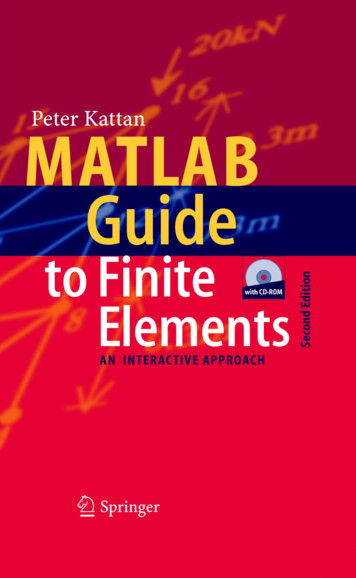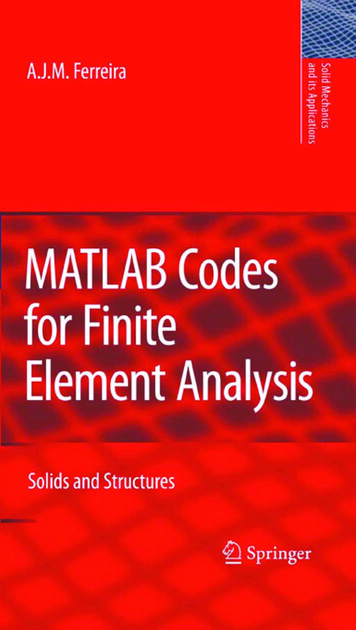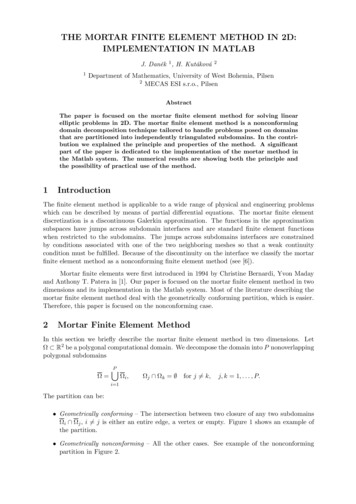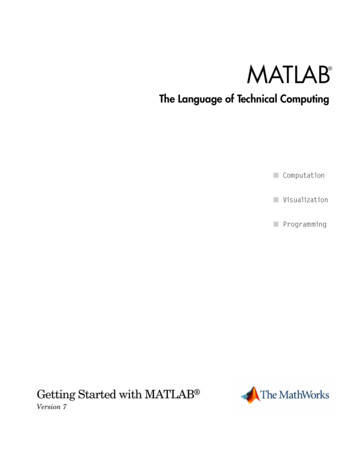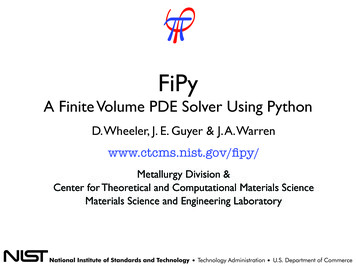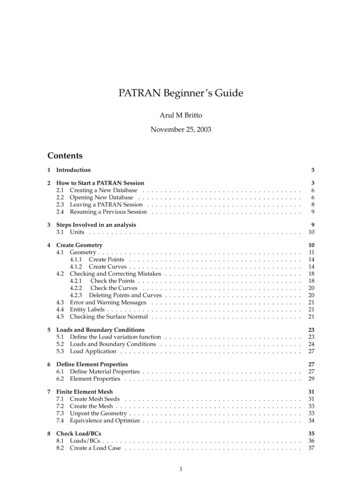
Transcription
Paper ID #9814MATLAB-Based Finite Element Analysis in a Vibrations ClassDr. John R. Baker, University of KentuckyJohn R. Baker is an Associate Professor of Mechanical Engineering at the University of Kentucky Extended Campus Program in Paducah, KY. He received his B.S., M.S., and Ph.D. in Mechanical Engineering from the University of Kentucky in Lexington, KY. After obtaining his B.S., he spent three yearsworking in the Plastics Division of Eastman Chemical Products, Inc. He entered his current position inJuly 2000.Page 24.889.1c American Society for Engineering Education, 2014
MATLAB-Based Finite Element Analysis in a Vibrations ClassAbstractThis paper overviews MATLAB -based assignments developed and implemented in amechanical vibrations class which utilize finite element analysis (FEA) for structural vibrationcalculations. The course is dual level and includes upper-level undergraduates taking it as atechnical elective, and graduate students taking it for graduate credit. In dual level courses, thereare additional requirements for graduate credit as compared to the work required forundergraduate credit. The course is offered via ITV (Interactive Television).A primary component of the paper is an overview of a graduate student project that requires thestudents to produce a flexible FEA program to analyze beam vibration using the MATLAB userfunction capability. This work is intended to solidify for the students the basics of structuralvibration analysis, including calculation of natural frequencies and mode shapes, and also forcedharmonic response analysis. It also provides an introduction to some students on FEA. Thosewho already have FEA experience gain more insight into development of a structural model,including mass, stiffness, and damping matrices, than they may obtain from use of standard FEAsoftware, such as ANSYS . Also, the students gain valuable programming experience, andbetter knowledge of the widely-used mathematical software tool, MATLAB.While undergraduates are not required to develop an FEA program, they utilize the finiteelement method through MATLAB functions developed by the instructor and provided to them,and the programming approach is outlined in lecture material.In some assignments, students compare finite element results to results based on other analysismethods to verify for them that the finite element analysis method is reliable. They also compareresults from FEA implemented using MATLAB user functions to results from the commercialFEA software, ANSYS. The assignments provide some insight into important issues such ashow results can be impacted by mesh density. This computational work complements a moretraditional coverage of vibrations topics, which is the main basis of the course.BackgroundPage 24.889.2As is the case with many engineering courses, there is much valuable information that could becovered in a single semester vibrations course, but the available time is limited. One challenge isprioritizing the topics to be covered. For engineering students to be well-prepared upongraduation, they need a good understanding of the underlying physics for the phenomena theystudy, and they also need up-to-date background on the tools used in industrial and researchsettings to analyze behavior of systems. FEA is currently the primary tool used in analyzing
vibrations of structures. In any practical use, FEA is implemented in a computer program. It is acomputer-based method of analyzing systems. It seems only reasonable to attempt to solve verysmall academic-type textbook FEA problems with a pencil, paper, and calculator. CommercialFEA software, such as ANSYS1, has advanced to the point that a person with essentially nobackground in vibration theory or in the fundamentals of the finite element method can readilyobtain solutions for vibration characteristics of complicated structures. It seems, however, that acompetent engineer should have an understanding of the basis for the software calculations andenough knowledge of vibration theory to notice when software results are unreasonable.MATLAB2, a widely-used software package, is a very useful tool in providing studentsopportunities to become more acquainted with FEA background, such as assembly of the globalsystem mass and stiffness matrices, and the matrix algebra operations involved in solving largestructural vibration problems. When a student writes his or her own finite element code in aMATLAB user function, it should solidify, at least to some extent, an understanding of whatcommercial FEA software is doing “behind the scenes”. It is hoped that the exercise of writingFEA code with at least some level of complexity may eliminate any mystery for the studentsregarding how commercial codes arrive at results, such as natural frequencies and mode shapes,and harmonic response amplitudes and phase angles.Inclusion of FEA in a vibrations course is certainly not a new idea. A quick review of fivevibrations textbooks with a wide range of publication dates indicates that FEA has been includedin standard vibrations textbooks for many years. Emphasis varies among authors. Of course,different textbooks have different target audiences and goals. The most recent edition of thetextbook by Thomson and Dahleh3 has a copyright date of 1998, and includes an introduction tofinite element methods in Chapter 10. The text has a total of 14 chapters. The textbook byMeirovitch4 includes a chapter on finite element methods, Chapter 8 of 12 total chapters, and itscopyright date was 1986. A very recent edition of a vibration textbook by Inman5, with acopyright date of 2014, discusses FEA in its final chapter, Chapter 8. However, the text byBalachandran and Magrab6, with a copyright date of 2009, does not appear to cover FEA.Neither does the text by Tongue7, with a copyright date of 2004. An exhaustive study of thetreatment of FEA in vibrations textbooks is beyond the scope of this paper, but the differences inemphasis in these texts is noted here to illustrate the fact that, while FEA has been used for manyyears in vibration analysis in industry, it seems reasonable to conclude that, at this time, there isnot universal agreement in the academic community on how much emphasis should be placed onFEA in a typical vibrations textbook.Page 24.889.3In addition to coverage in textbooks, inclusion of FEA in vibrations courses is outlined in otherwork. For example, Hagigat8 describes use of the ANSYS finite element analysis program tosolve vibration problems in a vibrations class, and states that FEA in the course supplementsclassical vibration analysis. The current author has reported on application of ANSYS FEAsoftware in teaching vibrations and other courses9,10.
Use of MATLAB in the teaching of vibrations has also been reported multiple times. Forexample, a MATLAB script to animate beam vibration is reported in Jacquot, et al.11 That workpresents several examples and states that the script should be of use to those teaching a secondcourse in vibrations. It does not discuss use of the script in a specific course.Additional examples of works involving various levels of use of FEA and MATLAB inengineering education and in particular, in vibrations, can be found because FEA and MATLABare widely-used tools in engineering. This paper primarily overviews some specific examples ofuse of the computer-based FEA in a mechanical vibrations course implemented through the useof the software package, MATLAB. This paper focuses on a specific graduate student project,and discusses four years of experience in implementing this project in class.In the sections that follow, some details of the vibrations course are summarized. The FEAbased graduate student project is then described. Assessment of the graduate student project isthen discussed, where the assessment is based on student performance on the project and studentresponses to questions on a survey. A discussion of possible modifications to the graduatestudent project is then provided. Additional homework assignments related to FEA are thendescribed, and the final section summarizes the overall work.Mechanical Vibrations Course OverviewMechanical Vibrations (ME-513) at the University of Kentucky includes undergraduate studentstaking the course as an elective and graduate students taking the course for graduate credit. It isoffered once a year, in the fall semester. It is taught via ITV (Interactive Television), withundergraduate students at the extended campus program in Paducah, KY taking the coursesimultaneously with undergraduate and graduate students on the main campus in Lexington, KY.The students taking the course in a given semester have a wide range of backgrounds. There issometimes a significant gap between the math skills and computer programming skills of agraduate student as compared to an upper-level undergraduate.Page 24.889.4It is university policy that students taking a 500-level course for graduate credit must do somework beyond that required for undergraduate students taking the same course. The difference inrequired work is left to the instructor’s discretion and must be described in the course syllabus.Of course, both undergraduates and graduate students attend the same course lectures. So, forboth sets of students, the same basic course material is covered. In the mechanical vibrationscourse, the primary difference is that the graduate students complete a project that is not requiredof the undergraduates. The graduate student project grade is used in place of about half thehomework credit for graduate students. So, for example, in fall 2013, homework accounted for15% of an undergraduate’s grade, but homework accounted for only 8% of a graduate student’sgrade, and the graduate student project accounted for 7%. The rest of the grade distributioninvolved exams and was the same for both groups. However, graduate students were still
required to complete all of the homework assignments as undergraduates. A second differencein requirements for the two groups is that occasionally graduate students have some additionalwork required on a given homework assignment as compared to undergraduates.While the assignments described in this paper show a significant emphasis on computer-basedFEA, the course also includes the more traditional approach to teaching vibrations, such asanalysis of lumped parameter models of simple systems with few numbers of degrees of freedom(DOF), and partial differential equation solutions of continuous systems.Graduate Student ProjectOverviewVarious projects were assigned for graduate students from the time the current instructor (thispaper’s author) first taught the course as a dual-level course in 2005 until 2009. In 2010, aproject requiring each graduate student to develop a somewhat flexible finite element analysisprogram for beam vibration analysis was implemented, and it has been used, with somemodifications, for four consecutive offerings of the course, 2010-2013. The program isdeveloped using the MATLAB user function capability (some may refer to MATLAB userfunction files as “m-files” because they have a “.m” extension to their filename).The assignment sheet for the most recent course offering in fall, 2013, is provided as anappendix. The basic features are: The finite element analysis program must perform modal analysis and steady-stateharmonic response analysis based on a 2D beam assumption.The modal analysis capability allows for calculation of undamped natural frequencies andthe corresponding mode shapes.In the harmonic response analysis option, a sinusoidal load, or loads, is assumed to act onthe structure, viscous damping is included in the model, and the steady-state responseamplitudes and phase angles are calculated for every DOF in the model.The program must allow for four different sets of boundary conditions at the ends of thebeam being analyzed.The program must conform to a specific set of user input guidelines and return results ina specific format.The students must perform analyses for five specific test cases, and submit a report on theresults, along with their MATLAB user function file.Page 24.889.5
Project GoalsSome goals of the project are:Goal 1: Students will gain some background in FEA applied to vibration problems.Goal 2: Students will gain some understanding of the relationship between the modeshapes calculated in an undamped modal analysis and the steady-state response when alightly-damped structure is excited at or near one of its natural frequencies.Goal 3: Students will gain some understanding of the convergence of FEA results tothose obtained from partial differential equation solutions for beams as the finite elementmesh density is increased.Goal 4: Students will gain some experience in structured computer programming.Regarding Goal 1, the time available in the course does not allow for extensive coverage ondetails of the FEA. However, in the course, finite element mass and stiffness matrices aredeveloped for simple spring and lumped mass systems, and also for rods, where the rod elementsallow only for axial motion. The method of superposition for assembling global system massand stiffness matrices from the individual element matrices is also presented, as well asimplementation of external loads in the model and the application of boundary conditions.Regarding 2D beam elements, a derivation of the element mass and stiffness matrices is notincluded in the course material. But, the beam element matrices are provided to the students, andthey are instructed that the assemblage of global system matrices and application of boundaryconditions is the same for beam elements as it is for the simpler elements. The 2D beamelements used have two end nodes per element. Assuming the beam element x-direction to bealong the beam element’s axis, there are two degrees of freedom per node: UY (lateraldisplacement in the y-direction) and RZ (rotation about the z-direction).Page 24.889.6In the course lectures and homework, a considerable amount of time is spent on simple lumpedparameter spring-mass-damper systems. Coupled second-order differential equations are writtenin matrix form, and the system mass and stiffness matrices, and sometimes a damping matrix, areidentified, and various types of calculations are performed. A theme repeated often to thestudents is that if they can understand the basics, such as calculation of natural frequencies andmode shapes, for a relatively simple 2-DOF case, then they really understand the basics for largesystem models, which are typically developed using computer-based FEA. The project isintended, in part, to clearly illustrate that the finite element method can be thought of as asystematic way of generating the system mass, stiffness, and damping matrices, and that themethod is very amenable to implementation in a computer program. Although there is readilyavailable finite element software on the market, it seems the details of how the mathematicalmodels are created and how the calculations are performed by the software may be lost on somestudents if they only use commercial FEA software.
Regarding Goal 2, one of the test cases the students consider, Test Case 3 (see appendix),involves calculation of natural frequencies and mode shapes for a simply supported beam (abeam with pinned constraints at each end). Another test case they consider, Test Case 5,involves calculation of steady-state response amplitudes and phase angles for a very lightlydamped simply supported beam assuming a sinusoidal force acts on the beam in the lateraldirection (perpendicular to the beam’s axis). The required analysis and plots for Test Case 5illustrate the fact that if a lightly-damped structure is excited at or near one of its naturalfrequencies, the response is dominated by the mode being excited. In other words, a snapshot ofthe beam when deformed in steady-state motion would reveal approximately the deformed shapedefined by the mode shape of the corresponding mode.To better explain how Test Cases 3 and 5 address Goal 2, consider the mode 2 mode shape of asimply
better knowledge of the widely-used mathem atical software tool, MATLAB. While undergraduates are not required to develo p an FEA program, they utilize the finite element method through MATLAB functions develope d by the instructor and provided to them, and the programming approach is outlined in lecture material.
